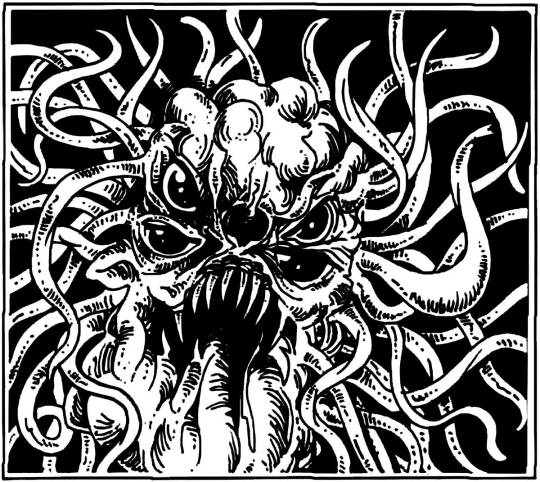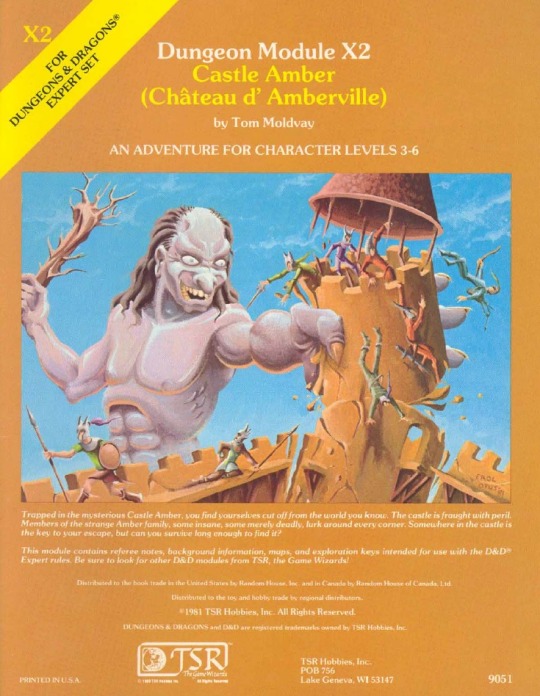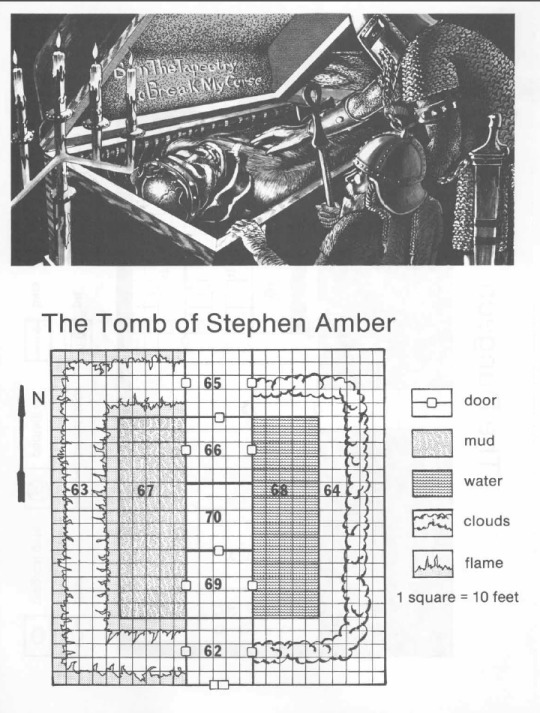#tom moldvay
Explore tagged Tumblr posts
Text

"Brain collectors, or Neh-Thalggu in their own language, are a race of other-dimensional creatures who are only occasionally able to cross the barriers separating their universe from this one. . . When these creatures slay characters, they carefully cut away the top of the head with surgical tools to expose the brain, and then swallow it. The brain then moves into one of several pockets within the brain collector's own head, forming a distinctive lump in the head of the monster. For each brain collected, the creature gains the ability to use one magic spell . . ." (AC09: Creature Catalogue, 1986, for BECMI D&D; the brain collector first appeared in Tom Moldvay's 1981 module X2: Castle Amber)
#D&D#Dungeons & Dragons#brain collector#dnd#BECMI#Creature Catalogue#Tom Moldvay#Castle Amber#tentacle monster#Neh-Thalggu#Neh Thalggu#lovecraftian#monster#Dungeons and Dragons#TSR
163 notes
·
View notes
Text



So for anyone interested in the differences of earliest DnD, I found this thread and made it visually easy to access.
(all credit for this goes to Adam Dray, check the link for the entire post)
#I was actually looking for early-game applications of Infravision before 3rd edition axed it#someone on a reddit thread mentioned a Darkvision description by Moldvay and... so this happened#I won't go through ALL the books in their entirety (at least not now) but there's certain things I seek inspiration from pan-editions#Some novels are an excellent source of applying game skills in-life as well but I like knowing WHAT abstract game concept is being morphed#plus inspiration#DnD#d&d#ttrpg#tom moldvay#frank mentzer#j. eric holmes#od&d#basic d&d#odnd#basic dnd#dnd basic#d&d basic#dnd basic revised#d&d basic revised#adam dray#dnd editions
13 notes
·
View notes
Text
115. Tom Moldvay - Dungeons & Dragons Basic Rules (1981)

So, in early 1981 we got a new version of the Basic Set which included character sheets, dice, rules and the B2: Keep on the Borderlands adventure module. I've covered Keep on the Borderlands before as it came out officially in 1979, so the only truly new thing in the set are the new Basic Rules. This rule book is basically an update of the 1977 J. Eric Holmes rules but there are some considerable changes.

One of the most immediately apparent changes is the fact that it's just a better and easier read. The rules are similar but better explained with more practical examples and some cool illustrations, also including a nice directory of monsters and magical items to be used in adventures spanning levels 1 to 3. One of the effects of this set, coming out. as it did, during the height of D&D fame, was to make Keep on the Borderlands one of the most popular of all adventure modules and certainly one of the most widely played.

There is another major change for the game, however. While Holmes' version created a continuity between D&D and AD&D, telling players that when they "graduated" from third level they should look to AD&D rules to continue playing their characters, this version distances D&D from AD&D by directing players to the Expert Set of D&D therefore not directing players to the Advanced version at all. With this set D&D is now a completely distinct game from AD&D, which even if that was the official position by Gygax in the pages of Dragon magazine, for example, was not really the case in practice. Next up, we will look at that Expert Set that came out at the same time as this Basic one.

30 notes
·
View notes
Text
1981 was a significant year for punk: not only were influential bands like Suicidal Tendencies, Sonic Youth, Butthole Surfers, and The Faith formed that year, it also saw the release of many punk classics: Damaged by Black Flag, Psychedelic Jungle by The Cramps, In My Eyes by Minor Threat, and the Dungeons & Dragons Basic Set by Tom Moldvay,
167 notes
·
View notes
Text

What RPG allows you to travel to the future to team up with the ghost of John Brown to violently overthrow corporate taskmasters? This week on the Vintage RPG Podcast, we look at Lords of Creation, my pick for the weirdest RPG ever made. Maybe. Designed by Tom “B/X” Moldvay, it’s one of the first multi-genre RPGs and it marked Avalon Hill’s (failed) first foray into RPGs. And, best of all, it is full of decisions that are just absolutely perplexing. A real testament to how easy it is from RPGs to get to the outer reaches of the bizarre.
#roleplaying game#tabletop rpg#ttrpg#dungeons & dragons#rpg#d&d#podcast#Avalon Hill#Lords of Creation
31 notes
·
View notes
Text

Title page illustration for Dungeon & Dragons: Basic Rulebook (Tom Moldvay Edition) ; Bill Willingham
11 notes
·
View notes
Text


Ranked #28 by Dungeon magazine's "The 30 Greatest D&D Adventures of All Time" (2004), B4 "The Lost City" by Tom Moldvay (1982, TSR) was intended for levels 1-3 of play, and left much of the remaining adventure hinted at so the DM could fill in the rest, including confronting the big nasty boss, Zargon. It featured a very early isometric map. Players lost no time charging in… on Map Monday aka Dungeon Day!!
6 notes
·
View notes
Text
B/X dnd has some fascinating monster lore man. Why do Neanderthals keep white apes as pets? Why are their leaders 10 ft. tall? Why do they have innate beef with ogres? What did Tom Moldvay know that palaeoanthropologists don't?
5 notes
·
View notes
Text
Review: Goodman Games' Original Adventures Reincarnated

As an old gamer who cut his teeth in the '80s with the D&D sets, I have a tremendous amount of nostalgia for those classic B-and X-series adventures. That's why I was excited to discover Goodman Games' Original Adventures Reincarnated series. It consists of 6 classic adventures that get a full treatment -- not only a reprint of the classic adventure, but a 5E remake and tons of extras like interviews with the original designers and expanded dungeons with all-new encounter areas. They call it a"Fifth edition conversion and classic homage" and it checks out.
My favorite so far is #4, The Lost City. As I mentioned in the past, the module's signature underground city was a huge influence on my Empire of Thieves campaign. In Goodman Games' revival, large amounts of new material have been offered, including a more complete description of the cult's influence on the city's society and expanded coverage of the city's goblin neighbors. They describe an empty dungeon that had been left by the original designer Tom Moldvay for dungeon masters to fill out.
I do want to ding Goodman Games for a couple of things. First, I don't know what the licensing and profit realities are, but I found the printing of the interior pages a little cheap. Most of the pages are 1-color, with color plates from the original module and classic blue maps. The various books have ribbon placemarks but I would have rather found a different value-add.
That said, I really like the books and hope to own all of them. These books are huge! The one I'm describing has over 300 pages and is hardcover bound. With all the extras, you really get a lot of value of out of them. If you are a fan of classic adventures, they are a must-have.
3 notes
·
View notes
Video
youtube
My RPG Journey Part 1 | Gaming on the Playground
This video begins a multi-part look into my experiences with role playing games, starting with my introduction to the hobby on the playground in 6th grade and my first RPG - the Dungeons & Dragons Basic Set by Tom Moldvay.
#youtube#pop culture#dungeons and dragons#d&d#vintage#rpg#moldvay#basic set#expert set#role playing games
0 notes
Text
B/X (also called Moldvay Basic, named after editor Tom Moldvay) is what people call the 1981 Basic/Expert D&D set, which is by far the most popular edition of Basic D&D.


Modern D&D editions are descended from the Advanced D&D product line (what people nowadays call 1e was actually not the first edition of the game, it was Advanced D&D 1e, which going by strict chronological order was actually like the third edition of the game lol). Running parallel to the Advanced D&D line was the now defunct Basic D&D product line, which stayed much closer to the contents of the original 1974 version of the game while streamlining and simplyfing a lot of rules and mechanics.
B/X or, the Basic / Expert set, is called that because it came in two books. The Basic Rules book contained character creation, character advancement up to level 3, rules for basic gameplay and dungeon exploration, as well as appropriately low-level spells and monsters, and came bundled in with a set of dice and the adventure module B2: Keep on The Borderlands, while the Expert Rules book contained character advancement from levels 3 to 14, rules for wilderness exploration, and higher-level spells and monsters, and came bundled in with the adventure module X1: The Isle of Dread.
I like B/X D&D bc it's pretty short and simple compared to both AD&D and modern D&D editions. Both books are like less than 150 pages long together and they contain everything you need to play. I don't like some of its mechanics (such as race-as-class) but overall I like its streamlined take on D&D's gameplay.
I think THAC0 gets kind of a bad reputation for being like a super unwieldy and complicated number crunchy mechanic among people who have never played a D&D edition that uses THAC0. I get that a lot of it is just meme culture being meme culture but still. Like yeah in hindsight it’s not like. The most intuitive way to do attack rolls, but imo the math behind is only like marginally more complicated than the way modern D&D handles attack rolls, if at all.
138 notes
·
View notes
Text

The previous resident of this dungeon room has unfinished business and would like to borrow your body for a while (Jim Holloway, D&D module B4: The Lost City by Tom Moldvay, TSR, 1982)
#D&D#Dungeons & Dragons#Jim Holloway#The Lost City#Tom Moldvay#spirit posession#spirit#ghost#undead#dungeon#dnd#Basic D&D#B/X D&D#TSR#Dungeons and Dragons
57 notes
·
View notes
Text
122. Tom Moldvay - X2: Castle Amber (1981)

By far my favourite adventure module up until now in the history of D&D modules, this is so much fun, packed full of ideas, influenced by some classic fantasy and weird fiction, Castle Amber is the granddaddy of haunted castle adventures, drawing from Edgar Allen Poe, Clark Ashton Smith and other to create a truly expansive story over only 28 pages.

We start off with out characters on some McGuffin mission and then get transported into the Castle, being stuck there and having to solve the puzzle to be able to return to the world of Mystara. The castle is surrounded by an impassable fog and seems to exist in its little dimension... does it remind you of something? Yep, Ravenloft owes much to this.

As the characters unveil the mysteries of the castle and encounter the colorful Amber family (a nod to Roger Zelazny's Chronicles of Amber) they eventually discover that they must go to a parallel universe where the France-like country of Averoigne exists and where they must travel from town to town to collect quest items to finally break the curse of the castle. Deeply atmospheric and fun this is a true classic.

26 notes
·
View notes
Note
You may have answered this elsewhere, but since you recently restated that you are a D&D player despite your (thoughtful and engaging) critiquing a d analysis of the medium/source material, which edition do you play, and which edition is your personal favourite?
I tend to prefer the TSR editions even though they're from before my time: I started with 3e and played it pretty much throughout its lifetime, and after playing 4e for some time I started exploring other games, including the older versions of D&D. My personal favorite is the 1981 Basic/Expert version by Tom Moldvay: it represents a playstyle that I think D&D really shines at and is just a lot of fun. I'm currently running an online open table using Old-School Essentials (a retroclone of B/X) for a bunch of cool people I've mostly met on Tumblr. :)
I do like all the other versions of D&D as well, with 4e basically being second place for me: as I said recently, it represents a playstyle I don't quite vibe with these days, but damn if it's good at that playstyle. I also have a lot of fondness for AD&D 1e and 3e, two games that despite major differences are more similar in design philosophy than one might think at first. I don't think there's a single edition of D&D I think is bad, but at the end of the day all I want to do is play the Stupid Edition where Elf and Dwarf and Halfling are classes.
40 notes
·
View notes
Link
Interesting stuff — campaign notes predating their publication as the default world of Moldvay/Cook/Marsh’s B/X D&D sets, later the foundation of Mystara
#D&D#Dungeons & Dragons#Tom Moldvay#Lawrence Schick#gaming history#Known World#Mystara#campaign setting#dnd#dungeons and dragons
53 notes
·
View notes
Text

Dragontales was published under TSR’s short-lived Dragon Publishing in 1981, with The Finieous Treasury as the only other product I know of appearing under the banner. It’s a collection of short fiction, mostly by authors whose names I don’t recognize. Three I do, but only Gardner Fox as an author of fiction — Roger Moore and Tom Moldvay I recognize as TSR designers. Every story is illustrated, one by Jim Holloway, one by Darlene, one by Kevin Siembieda. Most of the stories seem to be fictionalized versions of RPG sessions. I’ve never been really tempted to read any of them, but like Finieous, I kinda love that this existed. Shame it didn’t take off as a regular thing. Anyway, I don’t see this around too often, nor Finieous, so I thought it would be fun to share before saying goodbye to Dragon Magazine for the time being.
#roleplaying game#tabletop rpg#dungeons & dragons#rpg#d&d#ttrpg#dragon magazine#Dragon Tales#Dragon Publishing#noimport
76 notes
·
View notes